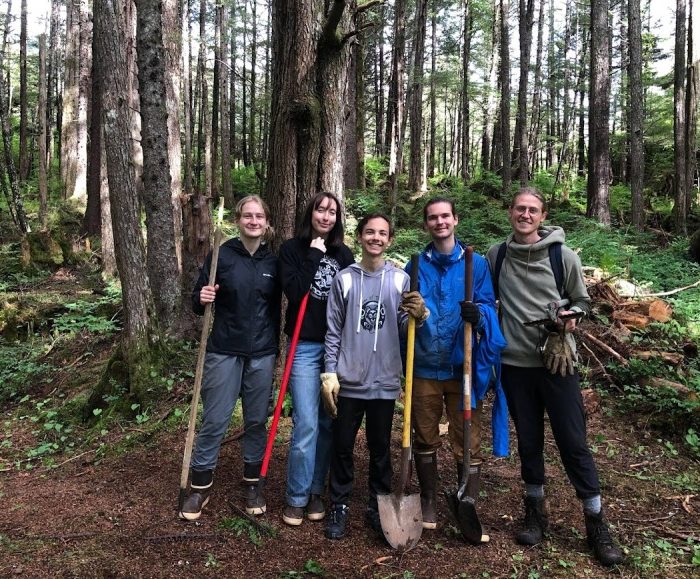
A small college in Sitka has announced it will be opening its doors to its first freshman class in the fall of 2024.
Outer Coast has been offering programs for high school students and high school grads in recent years, but is now poised to begin awarding Associate of Arts degrees.
Outer Coast offered its first summer sessions for high school students beginning in 2018. Two years later it opened a 9-month gap-year program for recent high school graduates. Operating in the pandemic proved to be a problem for many higher education institutions, but Outer Coast moved forward in-person, with an intensive alternative to traditional college.
Matthew Spellberg, Outer Coast Dean, says the transition to a 2-year degree program is going to stay this course.
“When we create the two year college, what it’s going to look like is a similar focus on students who are looking for something different from higher education and who maybe have felt that higher education as it conventionally exists has failed them or their communities or their families,” Spellberg said.
Spellberg has a Ph.D. in Comparative Literature from Princeton, and co-founded the Native Cultures of the Americas Seminar at Harvard. He is courting faculty from around the country who are interested in place-based education, and who can help rewrite how a western liberal arts education can incorporate traditional indigenous ways of knowing.
“And working to find a way for those two traditions, which have historically often been at odds with each other, and again, have generated a lot of sometimes ill will and alienation in certain communities can actually meet each other,” Spellberg said. “So we can be a kind of bridge between the classic college experience and something really different.”
Outer Coast was conceived in 2014 by a group of individuals, including Sitka Rep. Jonathan Kreiss-Tomkins, who saw potential in renewing a post-secondary program on the campus of the defunct Sheldon Jackson College in Sitka. That institution closed in 2007, sold off much of its property to cover debts, but donated the core campus to the Sitka Fine Arts Camp. The camp has thrived since moving onto the campus, but its facilities are mostly unused in winter.
Bryden Sweeney-Taylor along with Kreiss-Tomkins and several others, organized Outer Coast in 2015 with the objective of building a small college. It just took a while. Sweeney-Taylor is now the director of Outer Coast.
“We do feel like we’re on schedule,” said Sweeney-Taylor. “And we identified early on that the notion of starting a college from scratch was not going to be something that could happen overnight, and taking a step-by-step approach to that…. and now with the two-year liberal arts college proper, it feels like we’re in that place where we know what’s working. And that gives us the confidence to sort of take this next step.”
Sheldon Jackson has a complicated history. Prior to its decades as a four-year liberal arts college, it was a high school, an industrial training school, and a Native boarding school. The founders of the Alaska Native Brotherhood and Sisterhood were educated there. But it also was part of a territorial educational system that stripped and suppressed indigenous culture. Matthew Spellberg believes this dark history can be reconciled by following the lead of the indigenous community as the campus moves forward into a new era – for everyone.
“If we do this right, we will be able to bring the particular brilliance and energy that comes from thinking about an indigenous language into the sciences, into our study of place and the history of Sitka and of Alaska, into our study of the humanities into our study of great texts from whatever tradition,” Spellberg said. “And hopefully, it’ll lead to a place where students not only get an amazing, intensive immersion in this place, and the culture and tradition that is growing and evolving and has been for 1,000s of years in this place, but then also be able to carry that back to whatever place they’re going to and apply those same principles.”
Outer Coast makes no secret of the inspiration for its program: Deep Springs College, which was founded in 1917 on a working cattle ranch in eastern California. Bryden Sweeney-Taylor says Deep Springs is a starting point, rather than a goal, for Outer Coast.
“At this point I think (Deep Springs) is one of many inspirations for us for what Outer Coast can and hopefully will become,” said Sweeney-Taylor. “And we draw from lots of higher education histories and tradition in thinking about what Outer Coast can be… but I think we’ve been able to both broaden our perspective and to make some real decisions about the vision about Outer Coast that are significant departures from Deep Springs and from really any other institution that’s out there.”
Outer Coast will admit its first freshman class in the fall of 2024 – about 20 students. The following year, it will admit a similar number, for a total student body of 40. If all goes according to plan, the first degrees will be awarded at commencement in the spring of 2026.






























